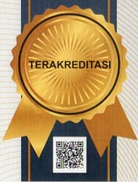Extraction and Characterization of Cellulose from Yellow Meranti (Shore macrobalanos) Sawdust Waste
Abstract
Meranti (Shorea macrobalanos) is a typical wood from Kalimantan that is still valued as a raw material of furniture production. According to statistical data, meranti sawdust waste reached 44% and has not been widely used. It is known that meranti has a high lignocellulose content, which are 38.18% of lignin, 26.03% of hemicellulose and 40.33% of cellulose. Due to the high cellulose level, meranti becomes an alternative source of cellulose which can be applied in composites, biomaterials, and membranes. Therefore, this study aims to produce cellulose from yellow meranti sawdust waste using an alkali treatment, NaOH 17.5%, with a variation of extract time of 20, 40, and 60 minutes. Cellulose characterization was performed using the Chesson-Datta method, Fourier-transferred Infrared Spectroscopy (FTIR), and Scanning Electron Microscope (SEM). The Chesson-Datta test showed that cellulose concentration escalated by increasing process time, which is 45%, 47% and 53% at 20, 40, and 60 minutes respectively. Increased levels of cellulose were followed by decreasing concentrations of lignin and hemicellulose. The FTIR results presented a strengthening of the intensity in the C-O-C functional group which indicated an increase in cellulose levels. Meanwhile, a decrease intensity was also revealed in the aromatic C=C and C=O groups, which implied a reduction in the amount of lignin and hemicellulose. Through the SEM, the surfaces were recognizably less dense by increasing extract time. It is because of the degradation of lignin and hemicellulose. Herein, the most optimum yield was achieved in 60 minutes to produce up to 53% of cellulose. Thus, yellow meranti sawdust waste has a high potential source of cellulose.
Keywords: yellow meranti, alkali treatment, cellulose
Abstrak
Meranti (Shoreamacrobalanos) merupakan kayu khas Kalimantan yang saat ini masih dimanfaatkan sebagai bahan baku pembuatan furnitur. Menurut data statistik, limbah serbuk kayu meranti yang dihasilkan mencapai 44% dan belum banyak dimanfaatkan. Telah diketahui bahwa meranti memiliki kandungan lignoselulosa yang cukup tinggi, yaitu 38,18% lignin, 26,03% hemiselulosa, dan 40,33% selulosa. Dengan kandungan selulosa yang tinggi, meranti menjadi salah satu alternative sumber selulosa yang kemudian dapat diaplikasikan di bidang komposit, biomaterial, dan membran. Oleh karena itu, penelitian ini bertujuan untuk menghasilkan selulosa dari limbah serbuk meranti kuning dengan menggunakan metode alkalisasi, NaOH 17,5%, dengan variasi waktu ekstrak selama 20, 40, dan 60 menit. Karakterisasi selulosa dilakukan dengan menggunakan uji Chesson-Datta, fourier-transferred infrared (FTIR), dan scanning electron microscope (SEM). Uji Chesson-Datta menunjukkan semakin lama waktu alkalisasi dapat meningkatkan konsentrasi selulosa, yaitu 45%, 47% dan 53% pada waktu alkalisasi 20, 40, dan 60 menit. Peningkatan kadar selulosa diikuti dengan menurunnya konsentrasi lignin dan hemiselulosa. Hasil FTIR menunjukkan penurunan intensitas pada gugus C=O yang mengindikasikan adanya penurunan jumlah lignin dan hemiselulosa seiring dengan meningkatnya waktu. Hasil morfologi SEM juga menunjukkan permukaan yang semakin tidak rapat seiring dengan meningkatnya waktu alkalisasi. Hal ini diakibatkan terjadi degradasi lignin dan hemiselulosa. Pada penelitian ini, hasil paling optimum dicapai pada waktu 60 menit dengan menghasilkan selulosa hingga 53%. Sehingga, limbah serbuk meranti memiliki potensi sebagai sumber selulosa yang cukup tinggi.
Kata kunci: meranti kuning, alkalisasi, selulosa
Full Text:
PDF (Bahasa Indonesia)References
I. S. M. Rafiqul and A. M. M. Sakinah, “Kinetic studies on acid hydrolysis of Meranti wood sawdust for xylose production,” Chem. Eng. Sci., vol. 71, pp. 431–437, 2012.
A. Ahmad, M. Rafatullah, O. Sulaiman, M. H. Ibrahim, and R. Hashim, “Scavenging behaviour of meranti sawdust in the removal of methylene blue from aqueous solution,” vol. 170, pp. 357–365, 2009.
M. Rafatullah, O. Sulaiman, R. Hashim, and A. Ahmad, “Adsorption of copper ( II ), chromium ( III ), nickel ( II ) and lead ( II ) ions from aqueous solutions by meranti sawdust,” vol. 170, pp. 969–977, 2009.
X. Zhang, “Characterizations of Bio-char from Fast Pyrolysis of Meranti Wood Sawdust Characterizations of Bio-char from Fast Pyrolysis of Meranti Wood Sawdust,” 2015.
P. Coniwanti, M. Dani, and Z. S. Daulay, “Pembuatan Natrium Karboksimetil Selulosa (Na-CMC) dari Selulosa Limbah Kulit Kacang Tanah,” vol. 21, no. 4, pp. 57–64, 2015.
Z. S. Ahmad, “Characterization of Meranti wood Sawdust and Removal of Lignin Content using Pre-treatment Process,” pp. 598–606, 2016.
Steven, Mardiyati, and R. Suratman, “Pembuatan Mikrokristalin Selulosa Rotan Manau ( Calamus Manan Sp .) Serta Karakterisasinya,” pp. 89–96, 2014.
G. W. Aniriani and N. F. Apriliana, “Delignifikasi dan EKstraksi Polisakarida Jerami Menggunakan Teknik Kimiawi sebagai Tahap Awal Pembuatan Bioetanol,” pp. 66–74, 2017.
I. B. W. Gunam, N. M. Wartini, A. A. M. D. Aggreni, and P. M. Suparyana, “Delignifikasi Ampas Teb dengan Larutan Natrium Hidroksida Sebelum Proses Sakaraifikasi Secara Enzimatis Menggunakan Enzim Selulase Kasar dari Aspergillus Niger FNU 6018,” no. January, 2011.
R. D. H. Putera, “Ekstraksi Serat Selulosa Dari Tanaman Eceng Gondok ( Eichornia Crassipes ) Dengan Variasi Pelarut Ekstraksi Serat Selulosa Dari Tanaman Eceng Gondok ( Eichornia Crassipes ) Dengan,” 2012.
DOI: https://doi.org/10.32487/jst.v5i2.704
Refbacks
- There are currently no refbacks.
Copyright (c) 2019 JST (Jurnal Sains Terapan)
View My Stats


